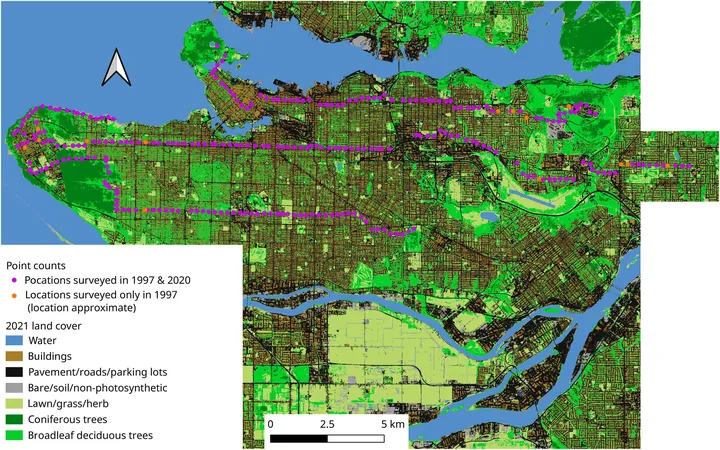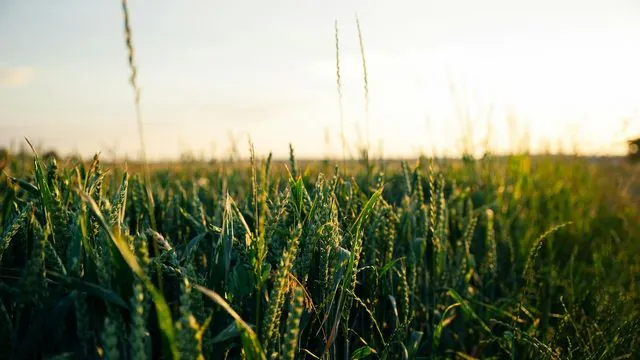
New Study Reveals Surprising Flexibility of Bird Species Amid Habitat Changes
2024-11-07
Author: Rajesh
Introduction
As global bird populations face significant declines, researchers from the University of Vermont have uncovered promising insights suggesting that some bird species exhibit greater adaptability to habitat changes than previously thought. This revelation opens up exciting possibilities for urban planting initiatives aimed at supporting avian populations.
Significant Findings
The findings, published in the Journal of Animal Ecology, emerge against a concerning backdrop: an estimated three billion birds have vanished from the skies of Canada and the United States over the past fifty years. Monitoring these population drops proves challenging, especially in the absence of consistent longitudinal data that tracks bird species over time.
Research Methodology
To address this, the research team employed a method known as 'space-for-time substitutions,' which forecasts future species populations based on data gathered at a single point. Lead author Harold Eyster, a climate scientist at the Nature Conservancy, examined a dataset of breeding bird species in the Vancouver metro area from 1997 to 2020, integrating information from satellite imagery and machine learning techniques to evaluate land cover changes alongside bird population trends.
Population Declines and Ecological Factors
Their analysis revealed a steep decline in total bird populations—26% overall, with house sparrows, barn swallows, and starlings suffering reductions of up to 80% and 90%. These changes indicate that other ecological factors beyond land cover alterations might be at play, suggesting that current models might be overstating the relationship between habitat changes and bird populations.
The Need for Comprehensive Surveys
Eyster emphasizes the need for expanded surveys that also consider birds' survival outside the breeding season. 'We are measuring one specific aspect, but birds must endure challenges year-round,' he noted, advocating for the protection of diverse landscapes that offer refuge and resources throughout the year.
Changes in Bird Composition
From 1997 to 2020, the composition of common bird species in the Vancouver area shifted notably. By 2020, chickadees and bushtits had outpaced swallows and sparrows in prevalence, with a notable rise in species like the northern flicker. This variability in population trends highlights inconsistencies with present space-for-time predictions, underscoring the need for more comprehensive ecological understanding.
Complex Environmental Factors
Co-author Brian Beckage, a professor in both Plant Biology and Computer Science at UVM, noted that complex systems often involve numerous uninterpreted environmental factors that can influence data models. He pointed out the significance of local landscape changes that could either alleviate or intensify the impacts on wildlife.
Importance of Longitudinal Studies
Longitudinal studies play a crucial role in clarifying these complex relationships, helping researchers gauge the variability of bird populations over time and identify driving factors influencing their survival. Beckage noted, 'Understanding when and how these ecological factors interact is critical for effective wildlife conservation efforts.'
Nature-Based Solutions
The research also aligns with exploring nature-based solutions to mitigate climate change, particularly within urban settings. Eyster and Beckage previously identified that conifers in Vancouver effectively cool urban areas during heatwaves, benefiting both wildlife and residents. Trees not only improve the environment and combat climate change by sequestering carbon but also provide habitats for birds.
Interactions Between Nonnative Species and Urban Wildlife
Eyster remarked on the irony displayed by many nonnative species facing steep population declines—typically found in densely populated regions—highlighting the unique interactions urban dwellers maintain with local wildlife. Given that over half of the world's population resides in cities, this presents a vital opportunity to nurture positive connections between humans and birds.
Innovative Research Approaches
In an innovative approach, Eyster replicated historical birding surveys from the 1960s and 70s in Vancouver, revealing that some bird species display more adaptable behaviors than current breeding surveys suggest. For instance, while the Pacific Wren typically inhabits vast forest areas during breeding, Eyster discovered they also move into residential cedars and shrubbery during fall and winter, showcasing their flexible nature.
Holistic Conservation Efforts
This study advocates for a more holistic view of conservation that encompasses not only large parks but also urban green spaces like backyards, which can be vital during various seasons. The researcher emphasizes that combating bird population declines goes beyond attributing causes solely to climate change; factors such as habitat loss, food supply variations, and competition from invasive species significantly contribute to these declines.
Disentangling Complex Relationships
Eyster's ultimate goal is to disentangle the complex web of relationships affecting bird populations, particularly the impact of human activity, suggesting that cities can become prime locations for fostering wildlife. With further investigation and community involvement, there may be an effective path toward safeguarding our feathered friends amid changing environments.
Collaborators
The study included contributions from researchers K.A. Chan of the University of British Columbia and undergraduate Morgan E. Fletcher from UVM.



 Brasil (PT)
Brasil (PT)
 Canada (EN)
Canada (EN)
 Chile (ES)
Chile (ES)
 España (ES)
España (ES)
 France (FR)
France (FR)
 Hong Kong (EN)
Hong Kong (EN)
 Italia (IT)
Italia (IT)
 日本 (JA)
日本 (JA)
 Magyarország (HU)
Magyarország (HU)
 Norge (NO)
Norge (NO)
 Polska (PL)
Polska (PL)
 Schweiz (DE)
Schweiz (DE)
 Singapore (EN)
Singapore (EN)
 Sverige (SV)
Sverige (SV)
 Suomi (FI)
Suomi (FI)
 Türkiye (TR)
Türkiye (TR)